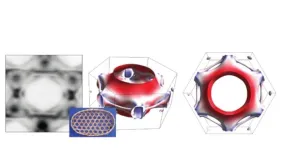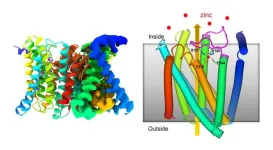(Press-News.org) Scientists from the Department of Energy’s Ames National Laboratory made an intriguing discovery while conducting experiments to characterize magnetism in a material known as a dilute magnetic topological insulator where magnetic defects are introduced. Despite this material’s ferromagnetism, the team discovered strong antiferromagnetic interactions between some pairs of magnetic defects that play a key role in several families of magnetic topological insulators.
Topological insulators (TIs) as their name indicates, are insulators. However, because of their unique electronic band structure, they conduct electricity on the surface under the right conditions. By introducing magnetism, TIs can transmit electrical currents from one point to another without any heat generation or energy loss. This quality means that they have the potential to reduce future energy footprints for computing and electricity transmission.
According to Rob McQueeney, a scientist from Ames Lab and a member of the research team, “Finding topological insulators is not so easy. You have to find this unique situation where the electronic bands are knotted up.” He further explained that applying a magnetic field to a TI turns the surface into a unique two-dimensional insulator, while the very edges of the surface remain metallic.
An important goal is to obtain a ferromagnetic TI. Ferromagnetism is when all of the magnetic moments in the material spontaneously align in the same direction. However, the team also discovered that TIs are susceptible to antiferromagnetic interactions when defects are introduced. Antiferromagnetism is when some of the ions spontaneously align with neighboring ions. The opposing magnetic forces decrease the overall magnetism of the material.
There are two ways that scientists introduce magnetism into a TI. The first is to introduce dilute amounts of magnetic ions, such as manganese-doped bismuth telluride or antimony telluride. The second is to create an intrinsic magnetic TI by inserting a layer of magnetic ions into the material, such as manganese-bismuth-tellurium (MnBi2Te4) and manganese-antimony-tellurium (MnSb2Te4). Since the intrinsic magnetic TIs have a full layer of magnetic ions, ideally the magnetism is not randomly distributed the way it is in the first method.
For this project, the team focused on dilute magnetic TIs, which have randomly distributed magnetic defects. “We wanted to understand the magnetic interactions at the most fundamental level. We were doping our sample using small amounts of magnetic ions to try to understand how the magnetic interactions occur,” said Farhan Islam, an Iowa State University graduate student and team member. “So basically, we're trying to understand how microscopic interactions affect the overall magnetism of the system.”
To conduct their research, the team used a specialized method called neutron scattering. This method involves passing a beam of neutrons (sub-atomic particles with a neutral charge) through a sample of material. Data is collected by noting where and when the neutrons that scattered from the sample hit a detector. This type of research can only be done a few places in the world. Neutron scattering for this project was conducted at the Spallation Neutron Source, a Department of Energy Office of Science User Facility operated by the Oak Ridge National Laboratory.
One challenge with neutron scattering is its weak signal. The team had concerns about studying dilute magnetism, because of the small overall number of magnetic ions. “I was very skeptical that we would see anything at all,” said McQueeney. “But we did. Actually, what we saw was pretty straightforward to observe, which was surprising.”
The team discovered that despite the overall ferromagnetism of manganese doped antimony telluride (Sb1.94Mn0.06Te3), some isolated pairs of magnetic defects are coupled antiferromagnetically with opposite moment directions. Other magnetic pairs, especially those in different blocks of the layered structure, are ferromagnetically coupled with parallel moments. The competing magnetic forces decrease the overall magnetism of the material.
“The intrinsic magnetic TIs actually have defects in it,” Islam explained. “So for example, manganese can actually go into the sites of antimony where they’re not supposed to be and the way the manganese is going into those sites is random.”
This random manganese site-mixing creates magnetic defects in the intrinsic magnetic TIs. The team found that the same interactions between defects in the dilute materials also occur in the intrinsic materials (i.e. MnSb2Te4). The magnetic ground state of the intrinsic magnetic TIs can be either ferromagnetic or antiferromagnetic, and the team now understands how magnetic defects control this behavior.
“We determined the interactions between defects in the dilute case and realized that these interactions are transferable to the intrinsic case,” said McQueeney. “By doing so, we conclude that defects control the magnetic order for both families.”
This research is further discussed in the paper, “Role of Magnetic Defects in Tuning Ground States of Magnetic Topological Insulators,” written by Farhan Islam, Yongbin Lee, Daniel M. Pajerowski, JinSu Oh, Wei Tian, Lin Zhou, Jiaqiang Yan, Liqin Ke, Robert J. McQueeney, and David Vaknin, and published in Advanced Materials.
Ames National Laboratory is a U.S. Department of Energy Office of Science National Laboratory operated by Iowa State University. Ames Laboratory creates innovative materials, technologies, and energy solutions. We use our expertise, unique capabilities, and interdisciplinary collaborations to solve global problems.
Ames Laboratory is supported by the Office of Science of the U.S. Department of Energy. The Office of Science is the single largest supporter of basic research in the physical sciences in the United States and is working to address some of the most pressing challenges of our time. For more information, please visit https://energy.gov/science.
END
Scientists make a surprising discovery about magnetic defects in topological insulators
2023-06-09
ELSE PRESS RELEASES FROM THIS DATE:
Novel ferroelectrics for more efficient microelectronics
2023-06-09
When we communicate with others over wireless networks, information is sent to data centers where it is collected, stored, processed, and distributed. As computational energy usage continues to grow, it is on pace to potentially become the leading source of energy consumption in this century. Memory and logic are physically separated in most modern computers, and therefore the interaction between these two components is very energy intensive in accessing, manipulating, and re-storing data. A team of researchers from Carnegie Mellon University and Penn State University is exploring materials that could possibly lead to the ...
Quantum materials: Electron spin measured for the first time
2023-06-09
An international research team has succeeded for the first time in measuring the electron spin in matter - i.e., the curvature of space in which electrons live and move - within "kagome materials", a new class of quantum materials.
The results obtained - published in Nature Physics - could revolutionise the way quantum materials are studied in the future, opening the door to new developments in quantum technologies, with possible applications in a variety of technological fields, from renewable energy to biomedicine, from electronics to quantum computers.
Success was ...
Seismic Waves tell lithospheric delamination mechanism in south China
2023-06-09
A research team led by Prof. ZHANG Haijiang from the University of Science and Technology of China (USTC) of the Chinese Academy of Sciences, and Prof. HOU Zengqian from Chinese Academy of Geological Sciences, revealed the seismically imaged lithospheric delamination and its controls on the Mesozoic Magmatic Province in South China by using a new joint seismic inversion algorithm. The study was published in Nature Communications.
Based on the latest developed seismic joint inversion algorithm, the researchers made use of the seismic body wave travel time, surface wave dispersion ...
Program for underrepresented undergraduate students in STEM receives NIH funding
2023-06-09
Alexandra Hanlon, director of the Virginia Tech Center for Biostatistics and Health Data Science, was recently awarded a $1.25 million grant from the National Institutes of Health (NIH) for a summer program aimed at promoting and diversifying the field of collaborative biostatistics.
The Collaborative Undergraduate Biostatistics Experience (CUBE), an eight-week summer program geared toward underrepresented undergraduate students, will receive $250,000 per year over the next five years through the NIH Research Education Program.
This R25 award, which is funded in a joint effort ...
USTC enhances fluorescence brightness of single silicon carbide spin color centers
2023-06-09
In a study published online in Nano Letters, the team led by Prof. LI Chuanfeng and Dr. XU Jinshi from the University of Science and Technology of China of the Chinese Academy of Sciences made progress in enhancing the fluorescence of single silicon carbide spin defects. The researchers leveraged surface plasmons to markedly boost the fluorescence brightness of single silicon carbide double vacancy PL6 color centers, leading to an improvement in the efficiency of spin control using the properties of co-planar waveguides. This low-cost method neither calls for complex micro-nano processing ...
Researchers determine quantitative composition of ultrahigh-pressure fluid in deep subduction zones
2023-06-09
In a study published in PNAS, Prof. XIAO Yilin’s group from the University of Science and Technology of China (USTC) of the Chinese Academy of Sciences (CAS) quantitatively determined, for the first time, the chemical composition of supercritical fluids in deep subduction zones, through 3D imaging modelling of ultrahigh-pressure (UHP) multiphase fluid inclusions, and revealed the important role of supercritical fluids in the cycling of carbon and sulfur in subduction zones, which is of great importance ...
USTC reveals reconfiguration process of solar eruptions
2023-06-09
Recently, a research team led by Prof. GOU Yanyu from the University of Science and Technology of China (USTC) of the Chinese Academy of Sciences (CAS) found that the solar outburst structure undergoes a complex reconfiguration evolution during the early outbursts, thus making important advances in the study of solar outburst activity. This study was published in Nature Astronomy.
In classical images, the core structure of a solar eruption is a magnetic rope consisted of spirally wound magnetic lines. When the eruption begins, the magnetic ropes around the core are transformed by magnetic reconnection ...
DNA facilitates escape from metastability
2023-06-09
Prof. LIANG Haojun from the University of Science and Technology of China (USTC) of the Chinese Academy of Sciences (CAS) proposed a new method to escape from metastability for self-assembly in a far-from-equilibrium system. The study was published in PNAS.
Self-assembly refers to the process in which assembled primitive elements (molecules, nanoparticles, etc.) spontaneously form ordered structures through non-covalent interactions. Its excellent capacity to create new materials has drawn attention. In an ...
Single quantum bit achieves complex systems modeling
2023-06-09
A team led by Academician GUO Guangcan from the University of Science and Technology of China (USTC) of the Chinese Academy of Sciences (CAS), with collaborative efforts from the University of Manchester, and Nanyang Technological University, has achieved new progress in applying quantum technologies in complex systems modeling. The results were published in Nature Communications on May 6.
Stochastic modeling can help us to predict the future behavior of complex processes, which are non-Markovian. In order to simulate a non-Markovian process, a memory is of necessity to store a large amount of observed information about the past of the system. However, ...
Zinc transporter has built-in self-regulating sensor
2023-06-09
UPTON, NY — Scientists at the U.S. Department of Energy’s (DOE) Brookhaven National Laboratory have determined the atomic-level structure of a zinc-transporter protein, a molecular machine that regulates levels of this crucial trace metal micronutrient inside cells. As described in a paper just published in Nature Communications, the structure reveals how the cellular membrane protein shifts its shape to move zinc from the environment into a cell, and temporarily blocks this action automatically when zinc levels inside the cell get too high.
“Zinc is important for many biological ...


